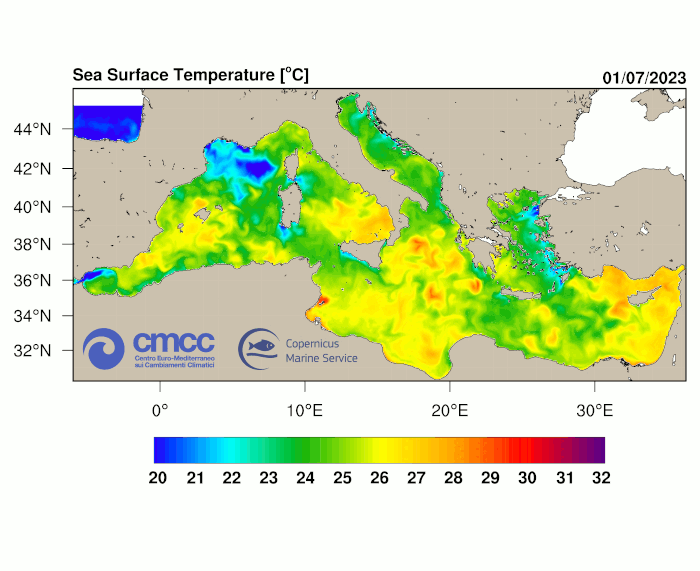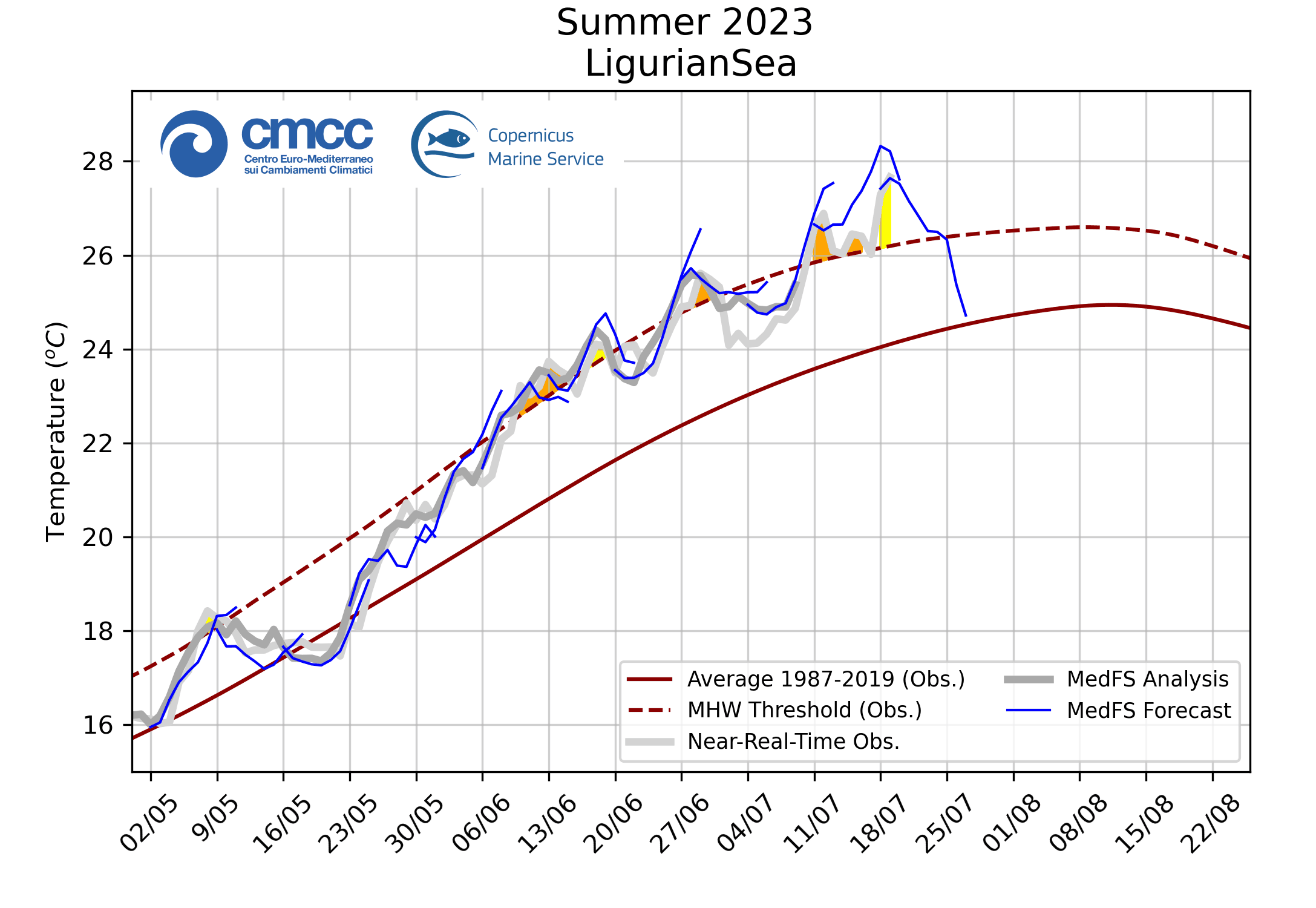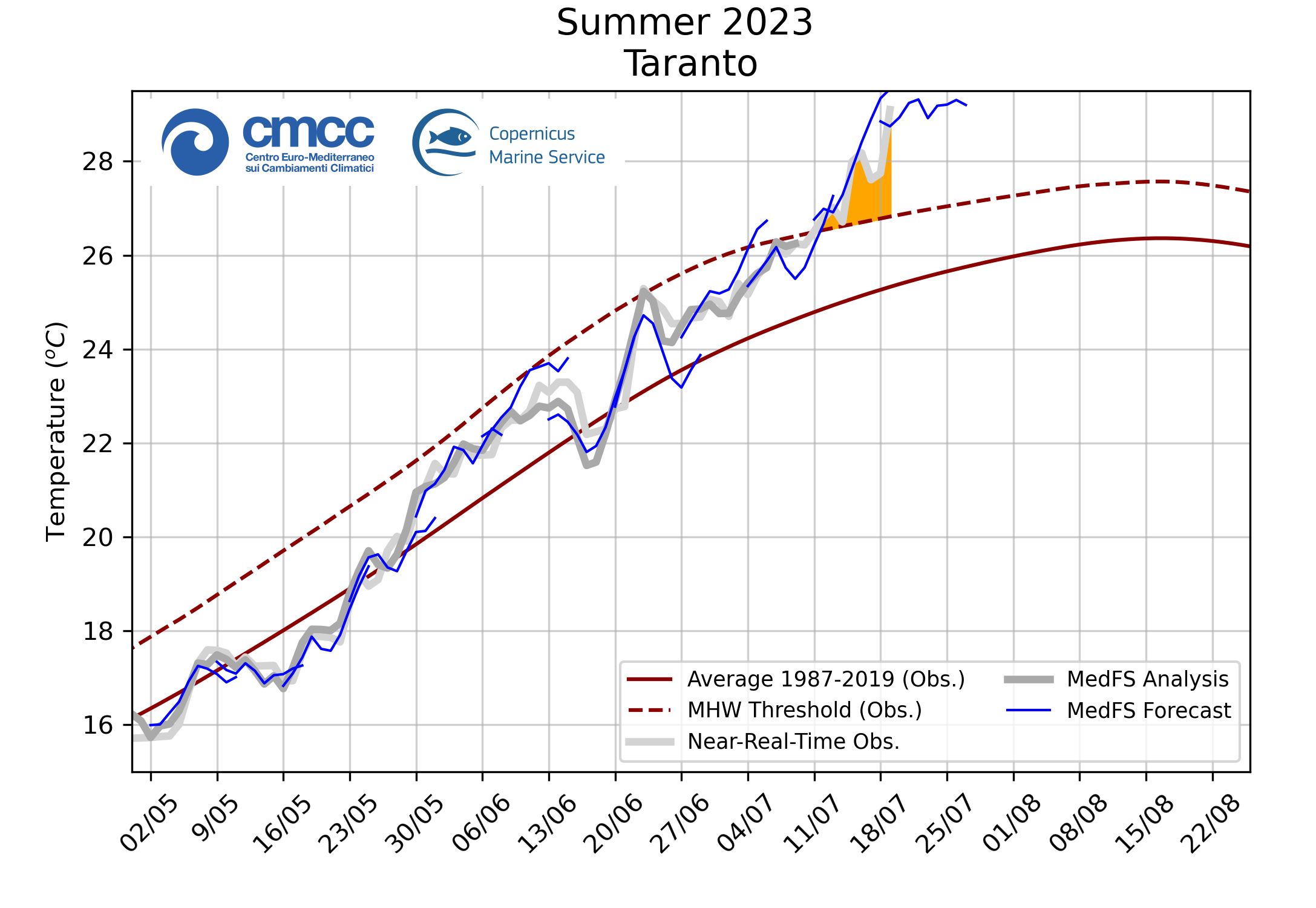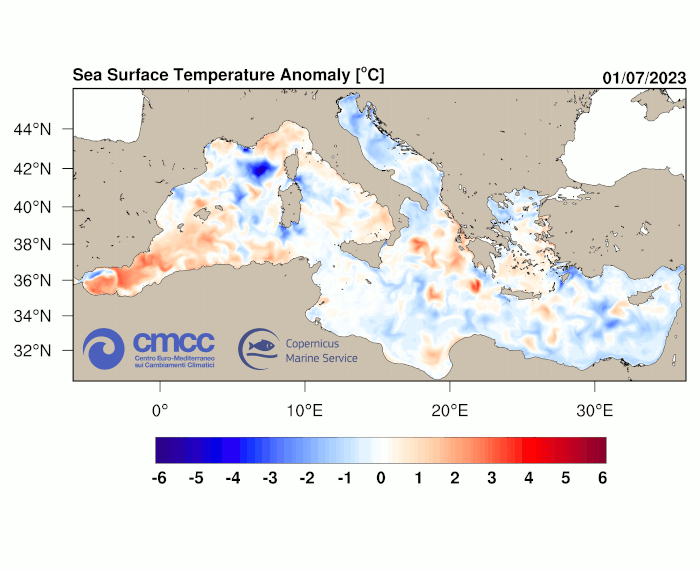
Significantly high temperatures are currently registered in the Mediterranean Sea, with values exceeding the average temperatures for the month of July by 5-6°C. The phenomenon has affected the Gulf of Taranto, and it is expected to intensify in the coming weeks. Images, animated maps, analyses, and forecasts from CMCC provided to the Copernicus Marine Service.
Current surface temperatures in the Mediterranean basin are warmer than usual, reaching levels of up to 5-6°C above climatological average. A marine heatwave (MHW) was observed since the beginning of July 2023, now spreading eastward across the Mediterranean Sea.
MHWs occur when ocean temperatures cross an extreme seasonally-varying threshold for more than 5 days in a row. Since July 11, 2023, a MHW has hit the Gulf of Taranto, where the surface water temperature has reached a peak of 30°C, 2°C higher than the threshold temperature.

Sea Surface Temperature, simulated from 01 to 18 July, 2023, and predicted from 19 to 28 July, 2023. Colours on the map show the values of sea surface temperature. Darker red and violet corresponds to higher temperatures, expected to reach up to 32°C in some areas between South Italy and North Africa.
“Our simulations show that we are currently in a condition where the mean sea surface temperature in the Mediterranean Sea is around 28°C, and it is expected to continue rising in the coming days, reaching above 30°C,” says Rita Lecci of CMCC’s Ocean Predictions and Applications (OPA) division. “Since the beginning of July we have observed a positive trend in the rising sea surface temperature, normal for summer conditions. From mid-July this started to be an anomaly because the sea surface temperature surpassed the climatological July threshold, computed over the last 30 years, for more than five consecutive days.”
Last year, a record-breaking marine heatwave in the Mediterranean Sea affected the Ligurian Sea for 3 weeks, later hitting the Gulf of Taranto with greater intensity, reaching nearly 5°C above average.
“Last year, we registered a marine heatwave phenomenon that we considered record-breaking, because it covered a large area of the Mediterranean with a persistent intensity,” says Ronan McAdam of CMCC’s Ocean modeling and Data Assimilation (ODA) division. “But this year it seems that the marine heatwave is centred in the North Atlantic and is manifesting itself mostly in the Western Mediterranean. I think that what has brought the heat up to the North Atlantic more westward in the Mediterranean is the anticyclones moving from Africa.”


Marine Heatwaves, summer 2023.
These plots represent the time series of surface temperature beginning at the start of May 2023 and going on to the present day. The pale gray line represents the Near-Real-Time observation, that is, satellite observations delivered through the Copernicus Marine Service that are considered as a truthful reference of what is happening day-by-day.
The full red line shows the average surface temperature for this time of year, calculated over a time period of 3 decades, from 1987 to 2019. The dashed red line represents the marine heat wave threshold, which is defined as the limit above which temperatures are in the 10% most extreme values, historically. Therefore, when temperatures rise above the MHW threshold for five days or longer, a marine heatwave is happening, shown in the plots with the orange colouring.
The yellow shading, on the other hand, represents so-called marine heat spikes, shorter extreme temperature events, which haven’t yet lasted for five days.
Finally, the blue lines represent the forecast, produced every week by CMCC, which has proved to be quite accurate as it correctly reflects real events and oscillations.
“Our forecast is predicting that in the next week the marine heatwave in the Ligurian Sea will weaken,” says McAdam. “On the other hand, we are expecting that the MHW in the Gulf of Taranto will continue, probably because the heat wave is shifting towards the centre of the Mediterranean. However, once the summer is finished, we can finally see which areas have been hit the most compared to the past.”
The Mediterranean Sea is a focal point for studying MHWs because the number of events, their duration and their intensity are increasing, and the basin is projected to be a real hotspot for climate change and global warming. “We expect to see a continuation of such events, and we expect to be talking about this every year,” says McAdam. “At the moment, we may be learning about MHWs by comparing different years and different events, but when it comes to the drivers and the causes of marine heat waves in the Mediterranean, there still has to be a proper, rigorous study.”

Sea Surface Temperature Anomaly, simulated from 01 to 18 July, 2023, and predicted from 19 to 28 July, 2023. Colours on the map show the difference between the daily sea surface temperature and the climatological July values computed over 1987-2020 yrs from Mediterranean Sea reanalysis (provided to Copernicus Marine Service). Darker red corresponds to higher anomaly, reaching up to +6°C.
“What is interesting to see in our simulations is that, following the temporal evolution of the colours on the map, we can observe that towards the end of the month we are expecting areas with intense red color, indicating that the sea surface temperature will be above 5°C compared to the July climatological value,” says Lecci.
This increase in sea temperature has a significant impact on marine ecosystems, especially the fish fauna, as many fish species have an optimal life range within specific sea temperature values. Beyond these values, exceeding the threshold, the fish fauna could suffer, die, or no longer be able to reproduce, leading to the possibility of finding very different species in our Mediterranean Sea in the not-too-distant future. So-called alien species, such as tropical fish, are now able to find a suitable environment and suitable conditions for their life in the Mediterranean Sea due to the increasing sea temperature. “What we will witness in the near future is a change in ecosystems, fish fauna, and even plant life,” says Lecci. “This also affects humans because it changes the quantity and quality of the fishing products. We must adapt to what is to come, which is quite unknown. But we are already beginning to see its effects.”
More information about the impacts of climate change on the Mediterranean area can be found in the IPCC Climate Change 2022 Report.


